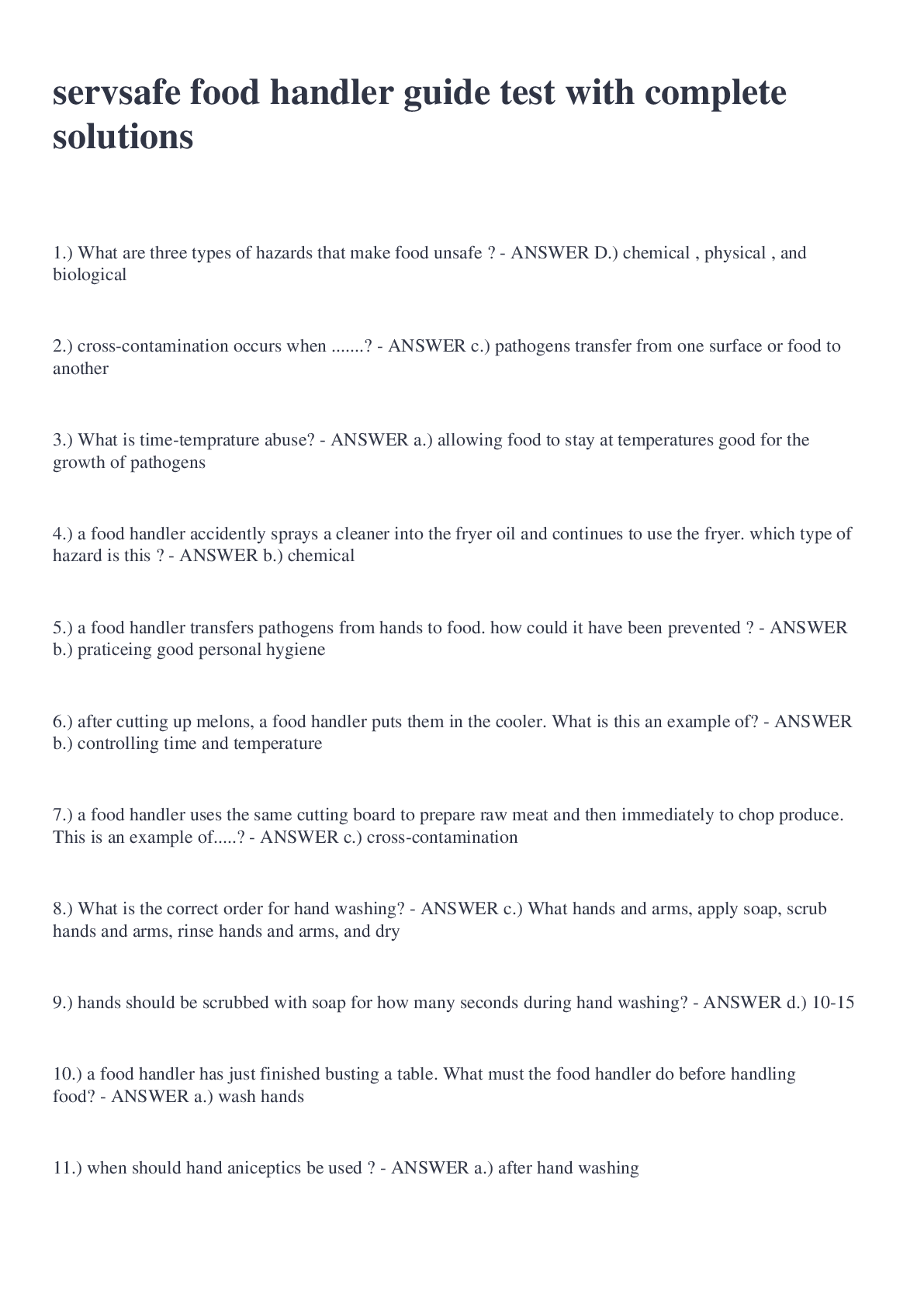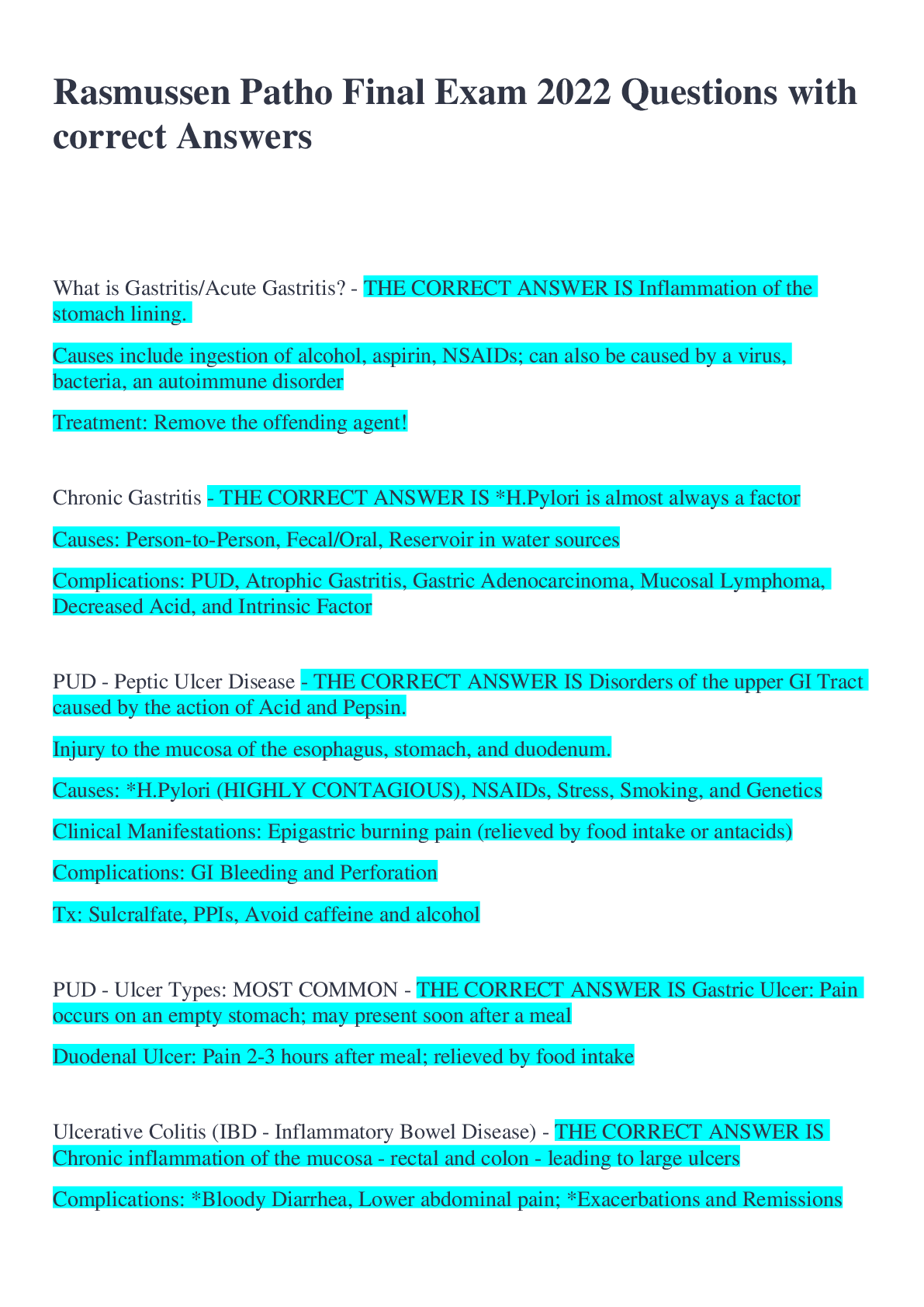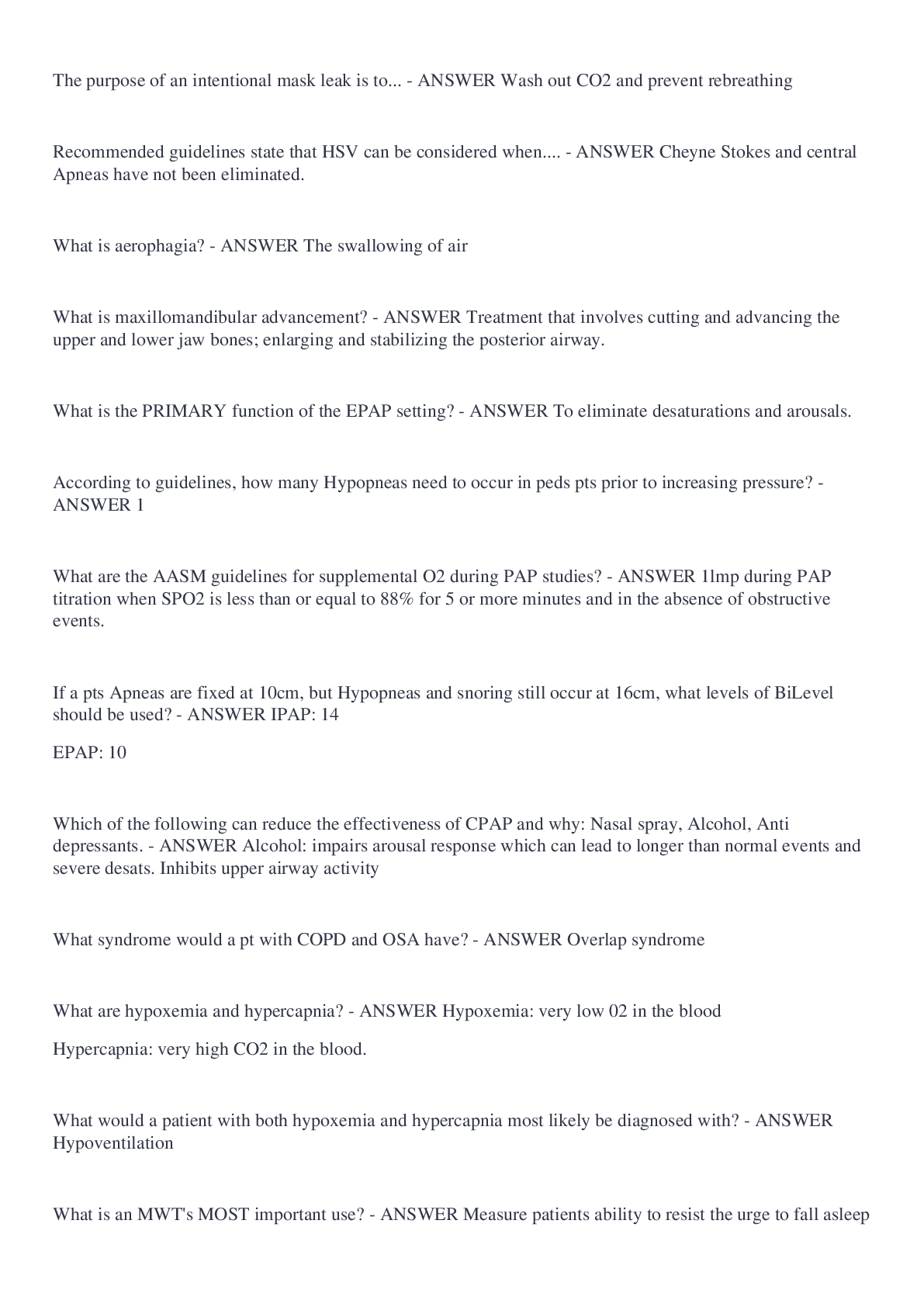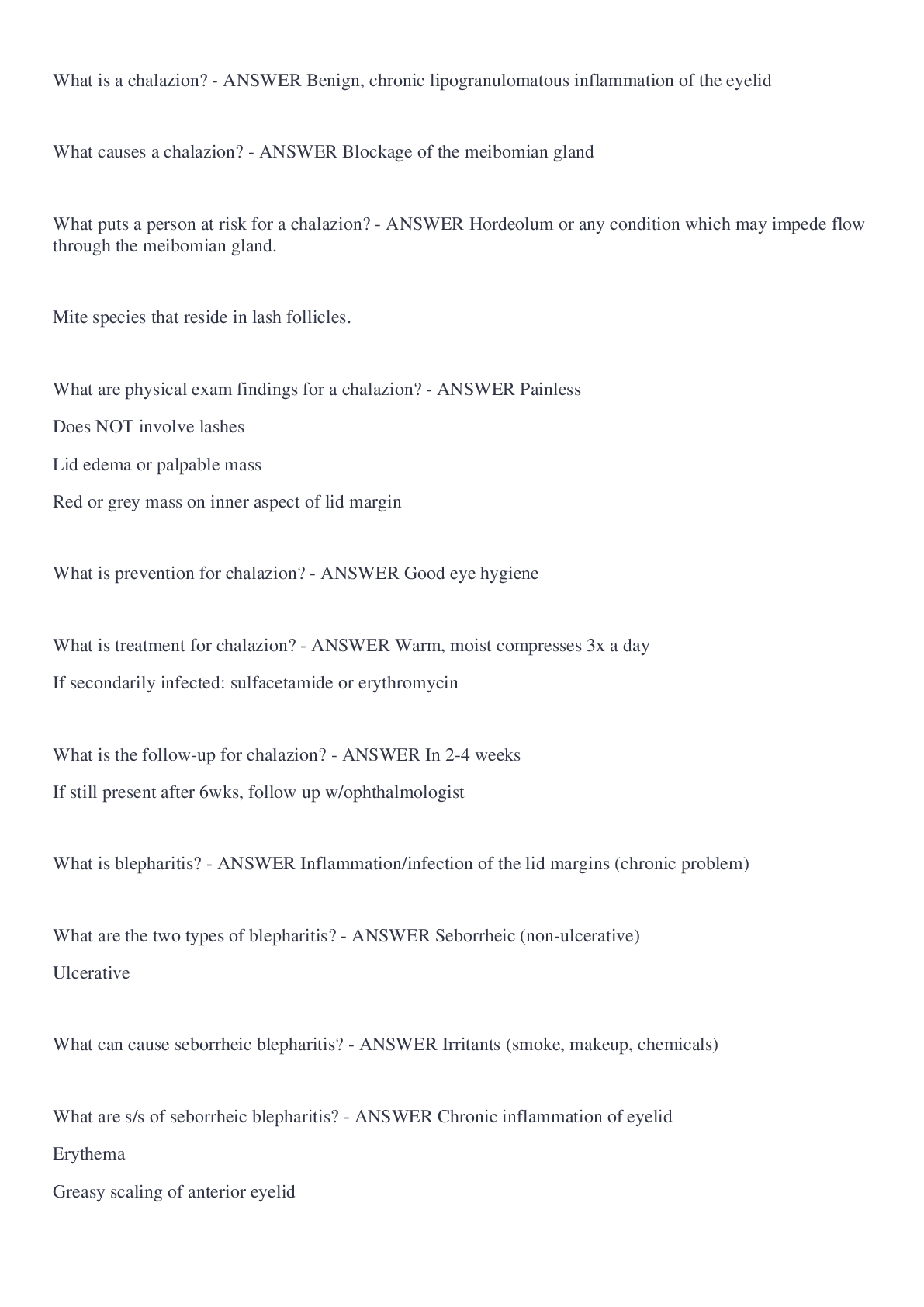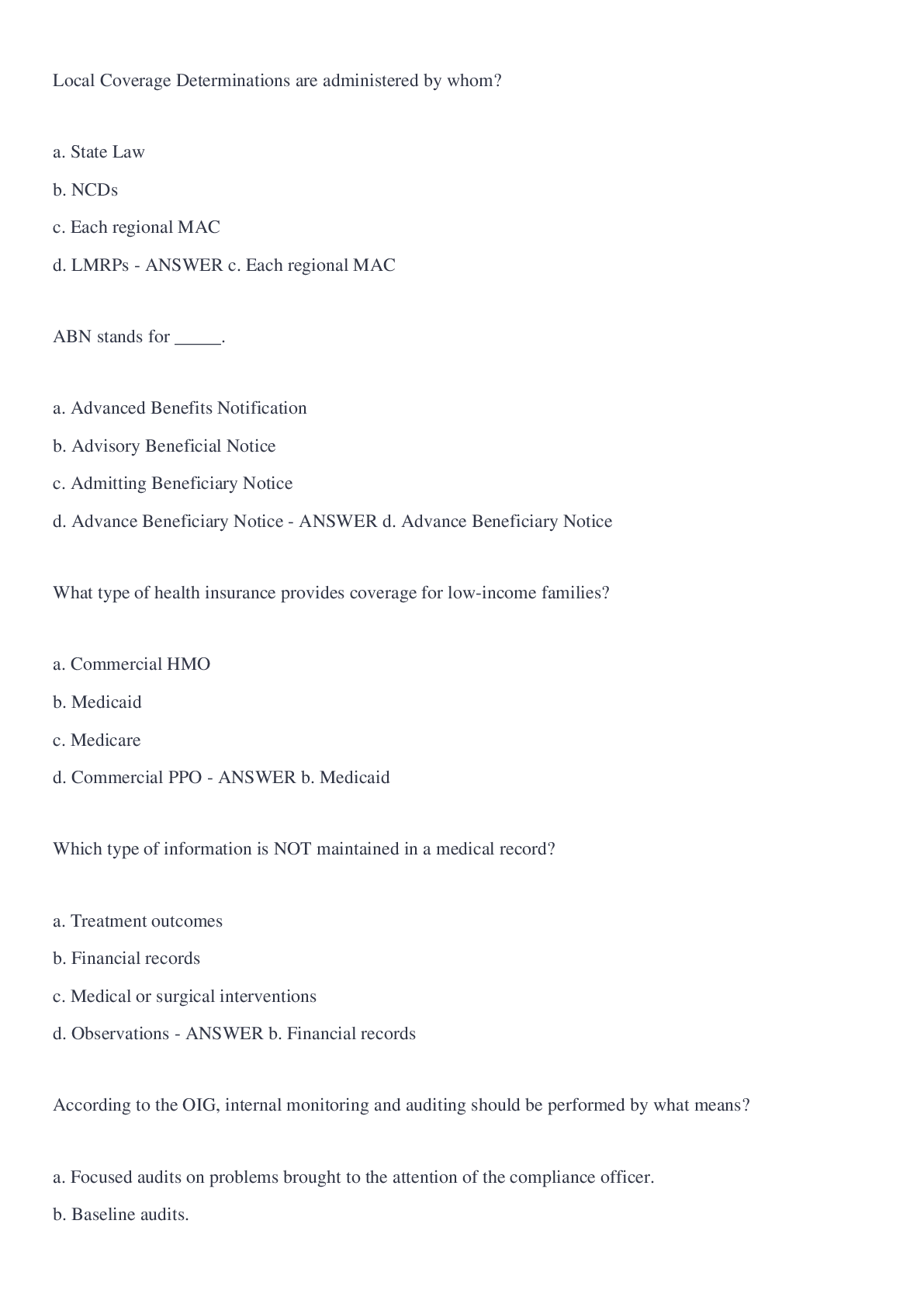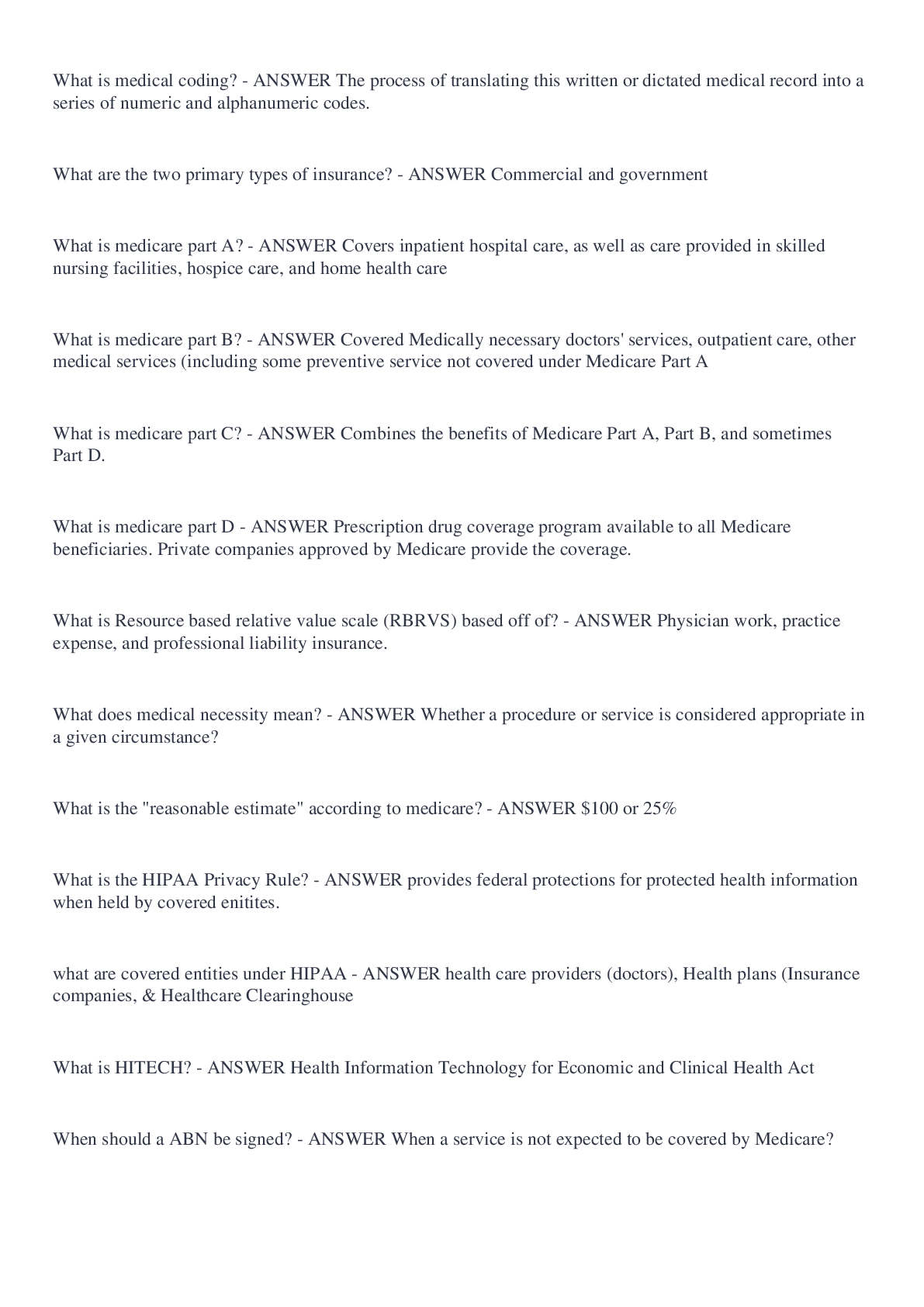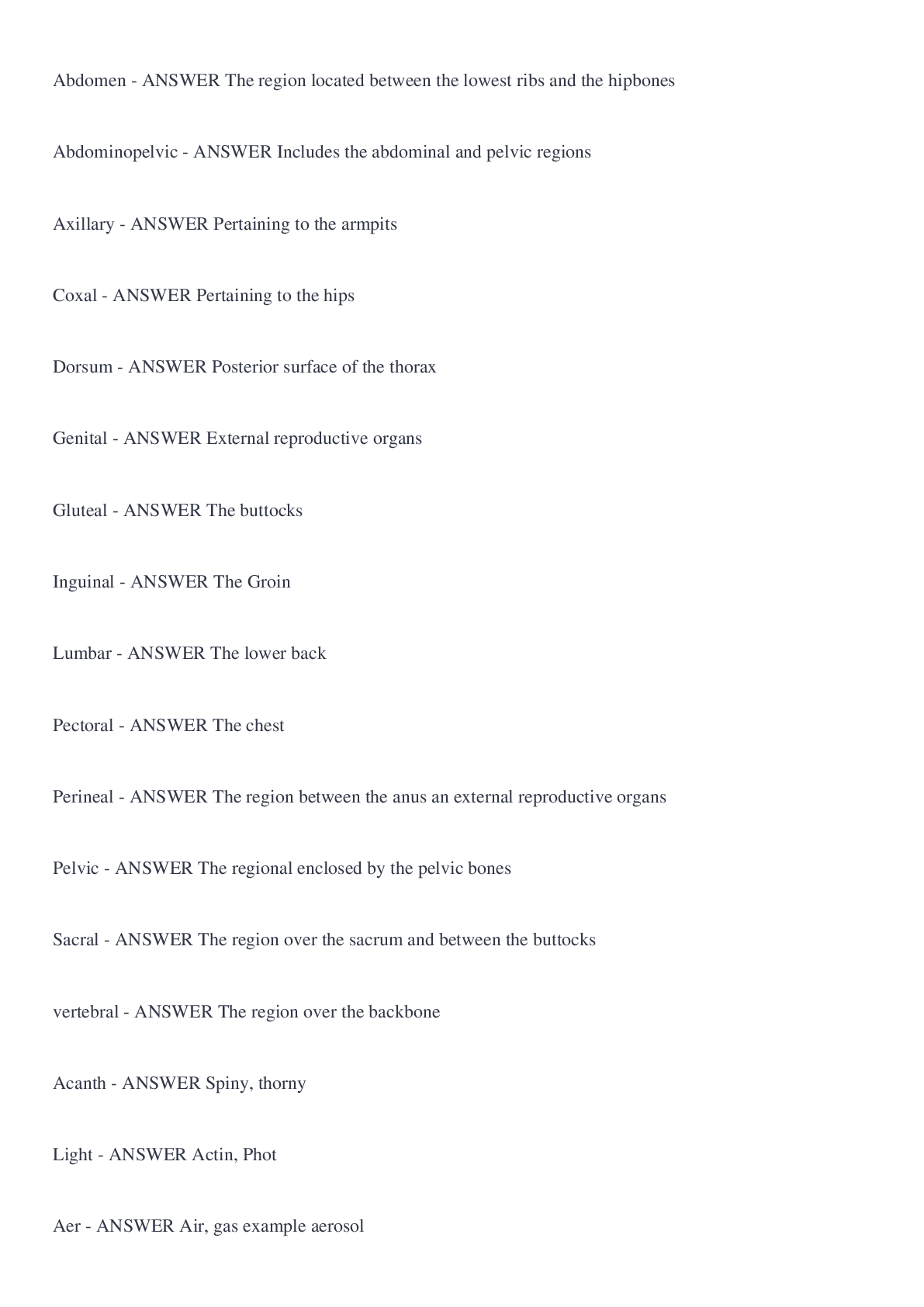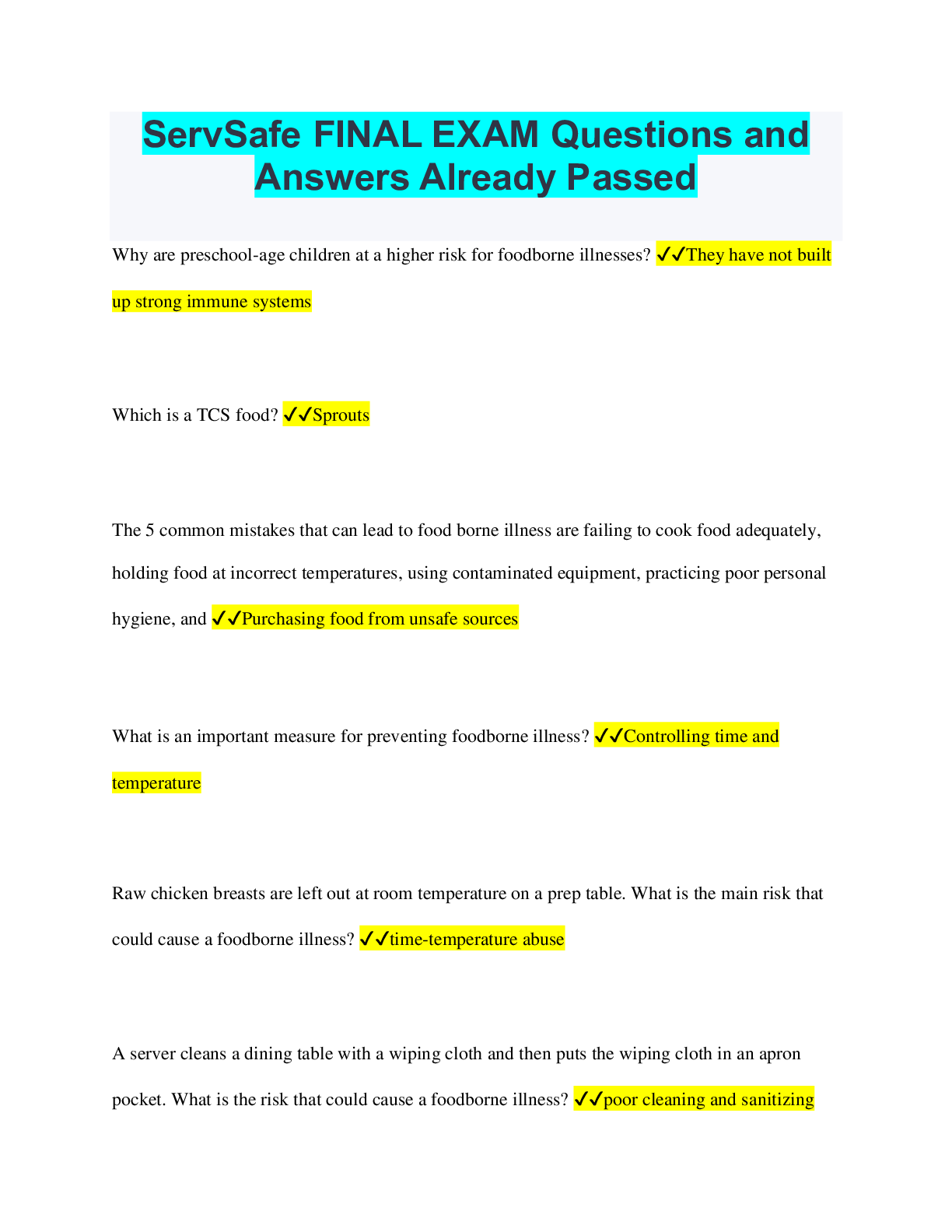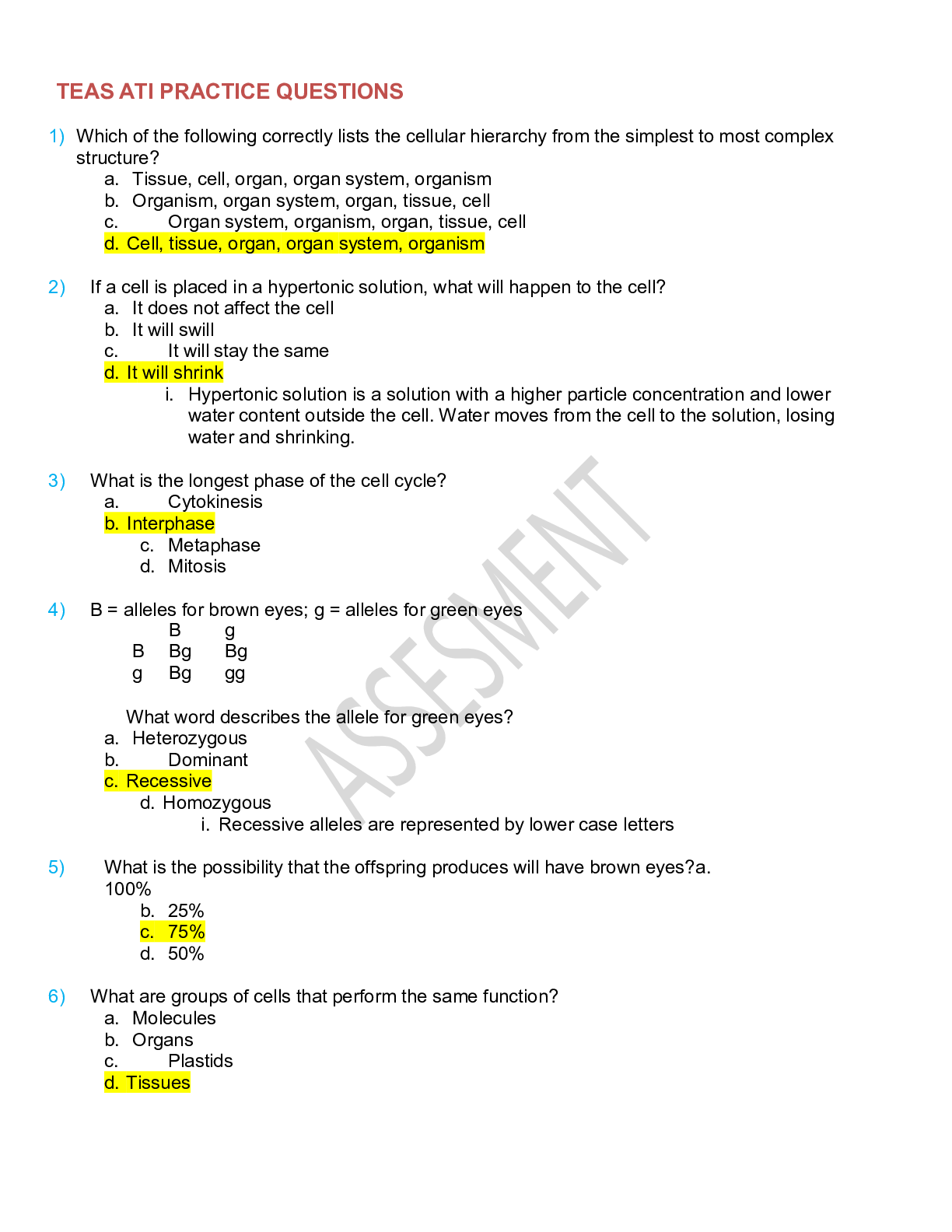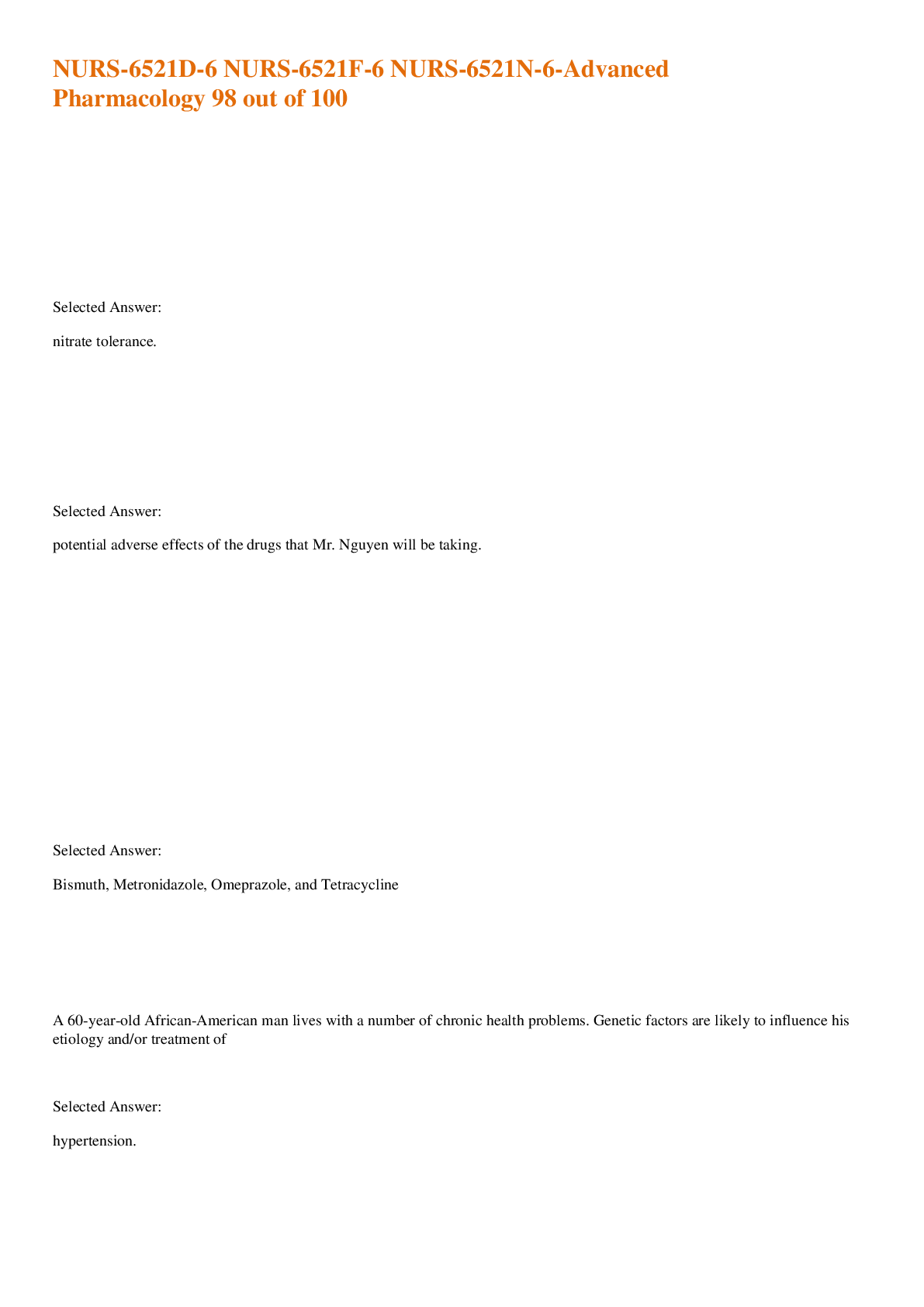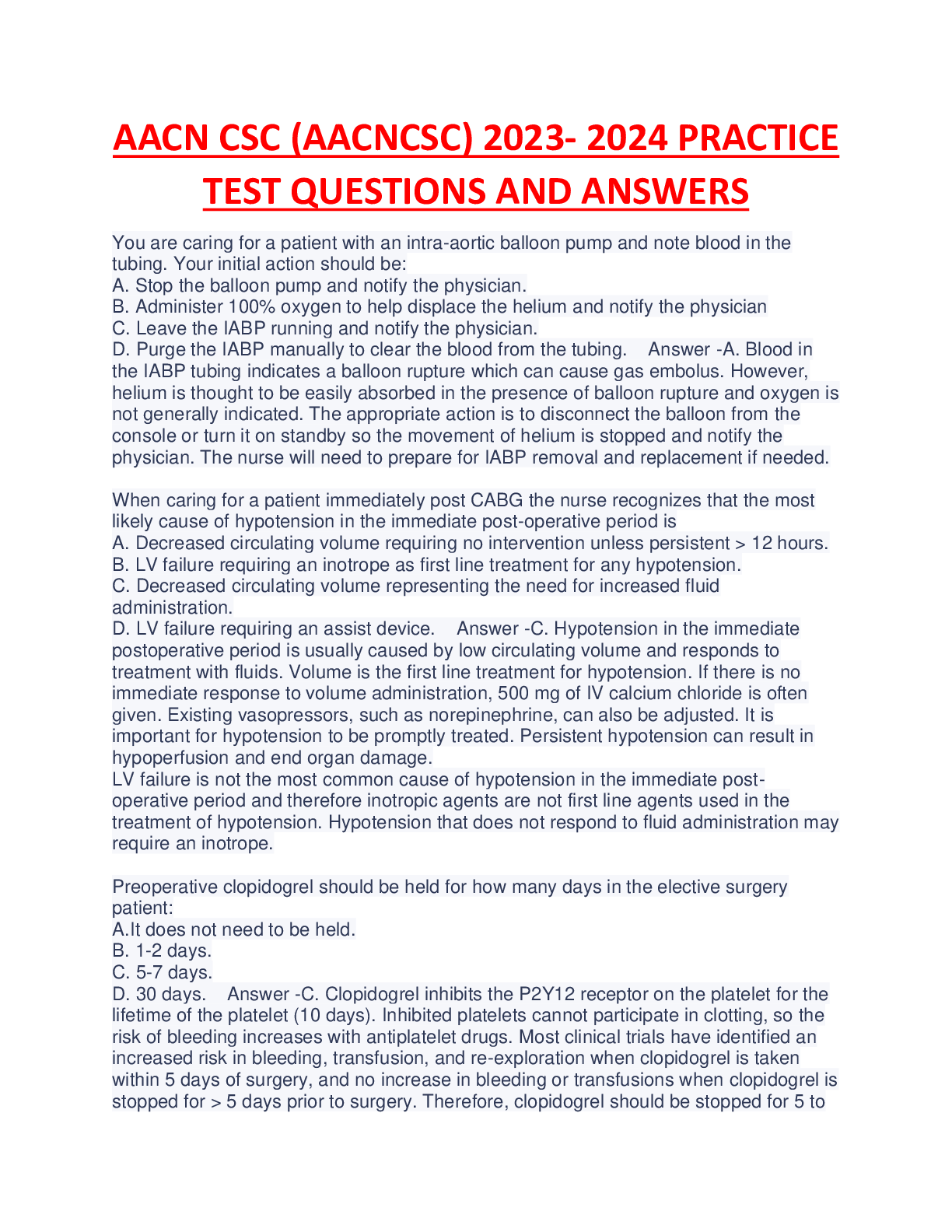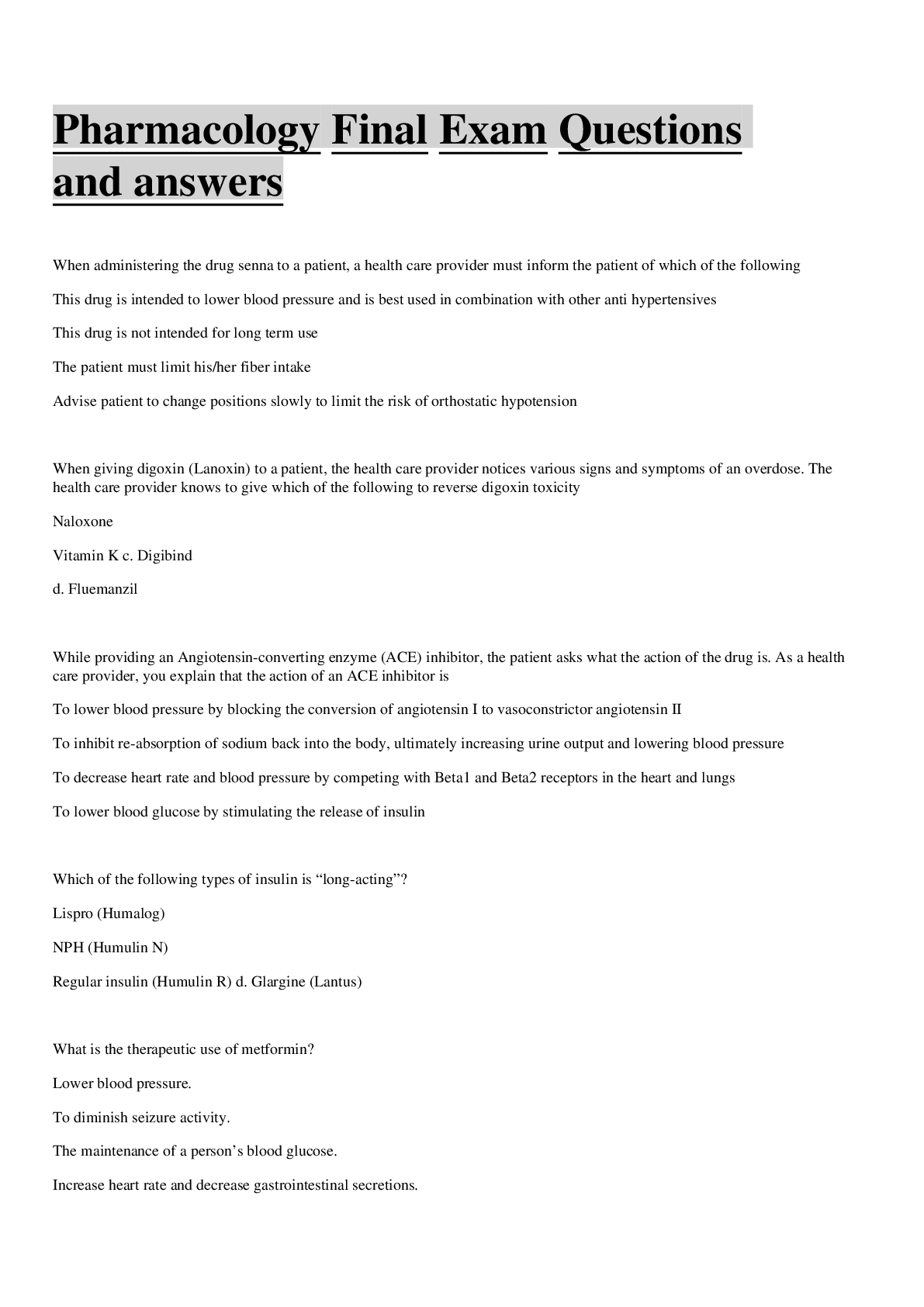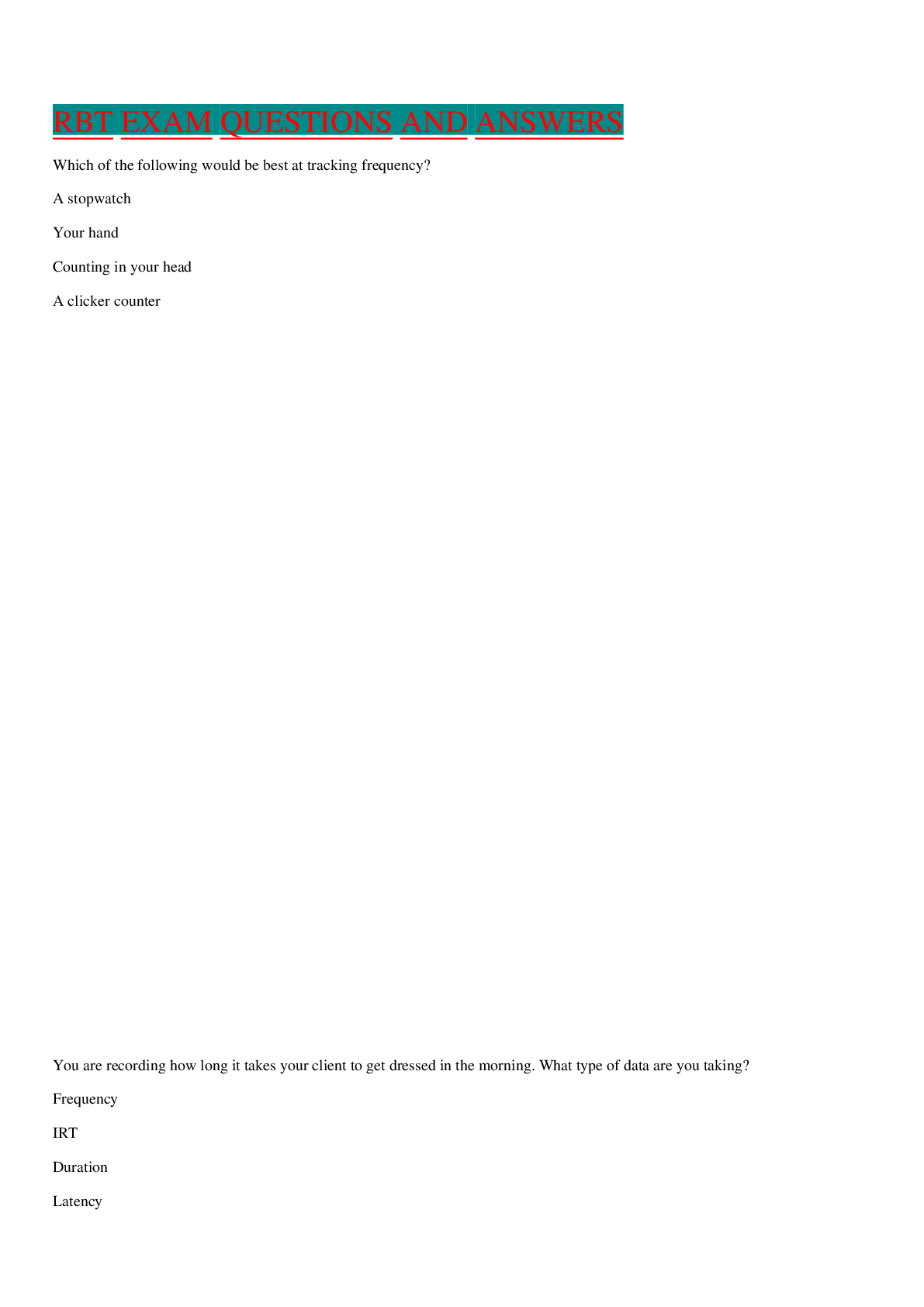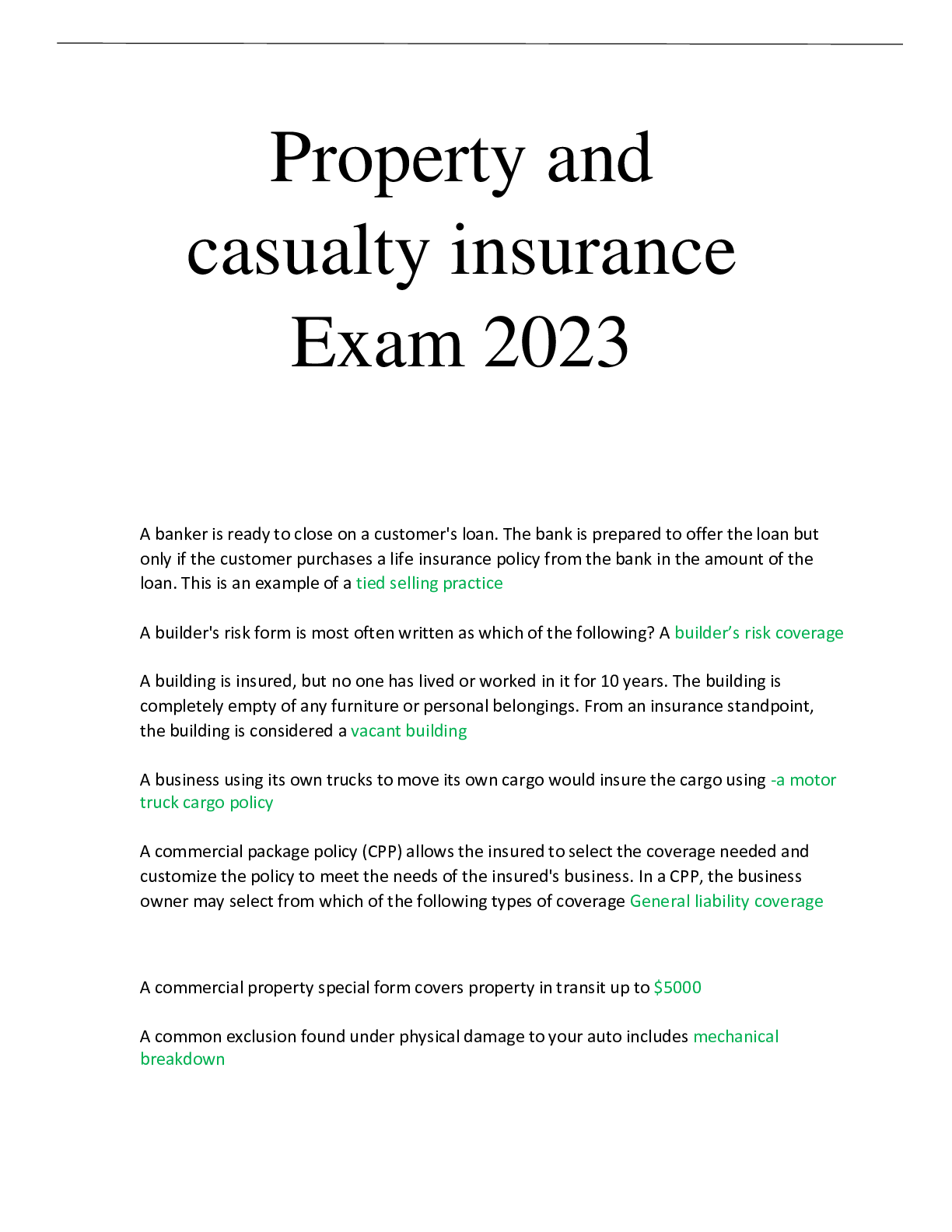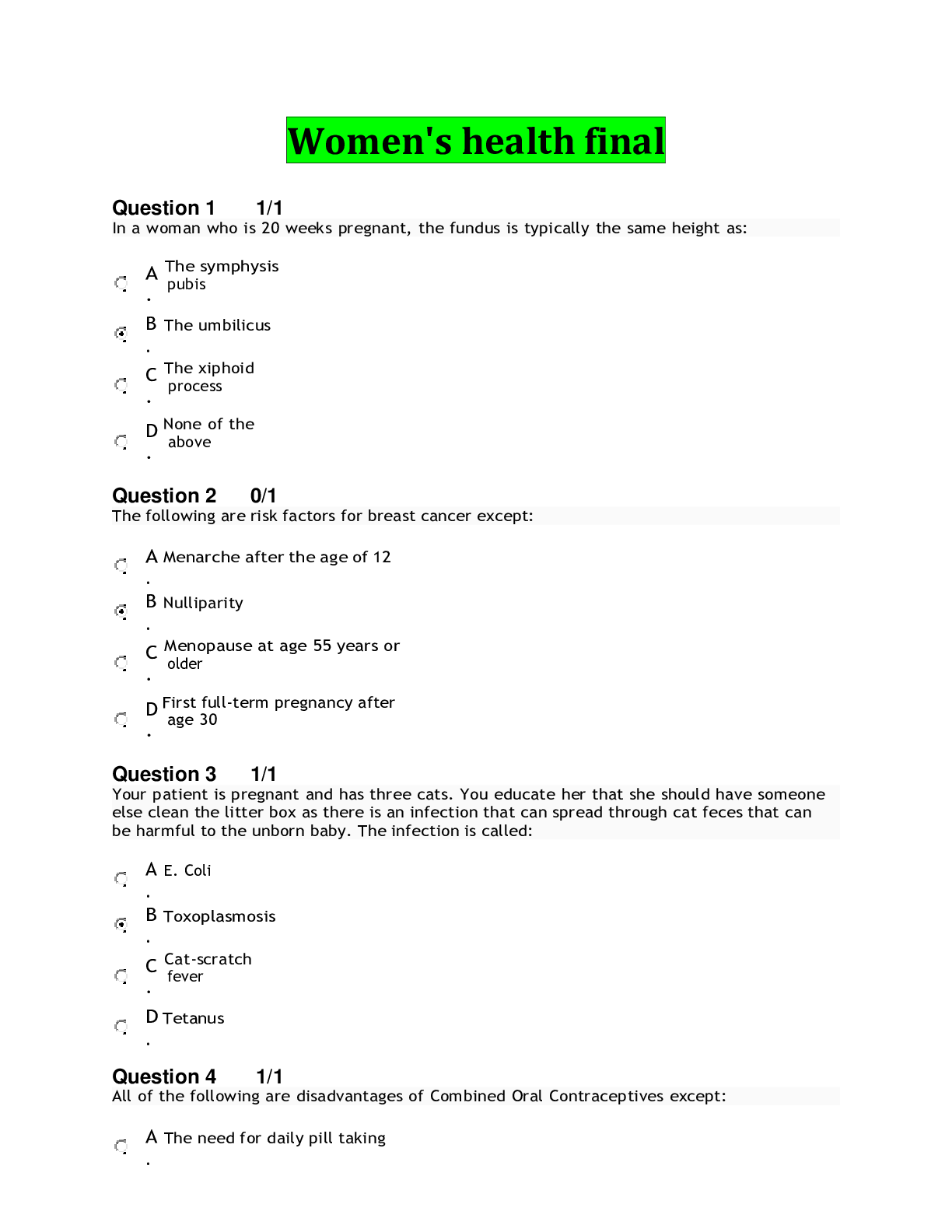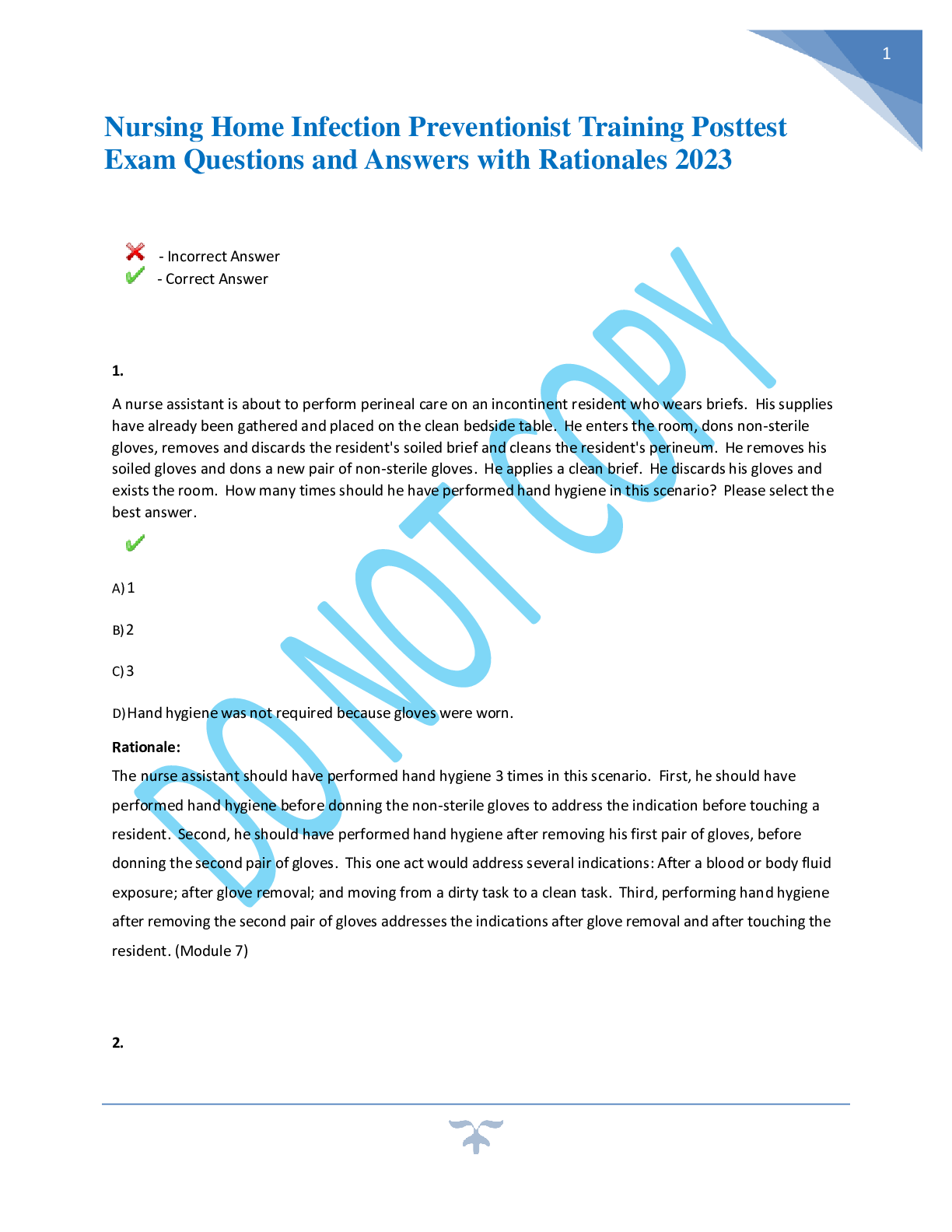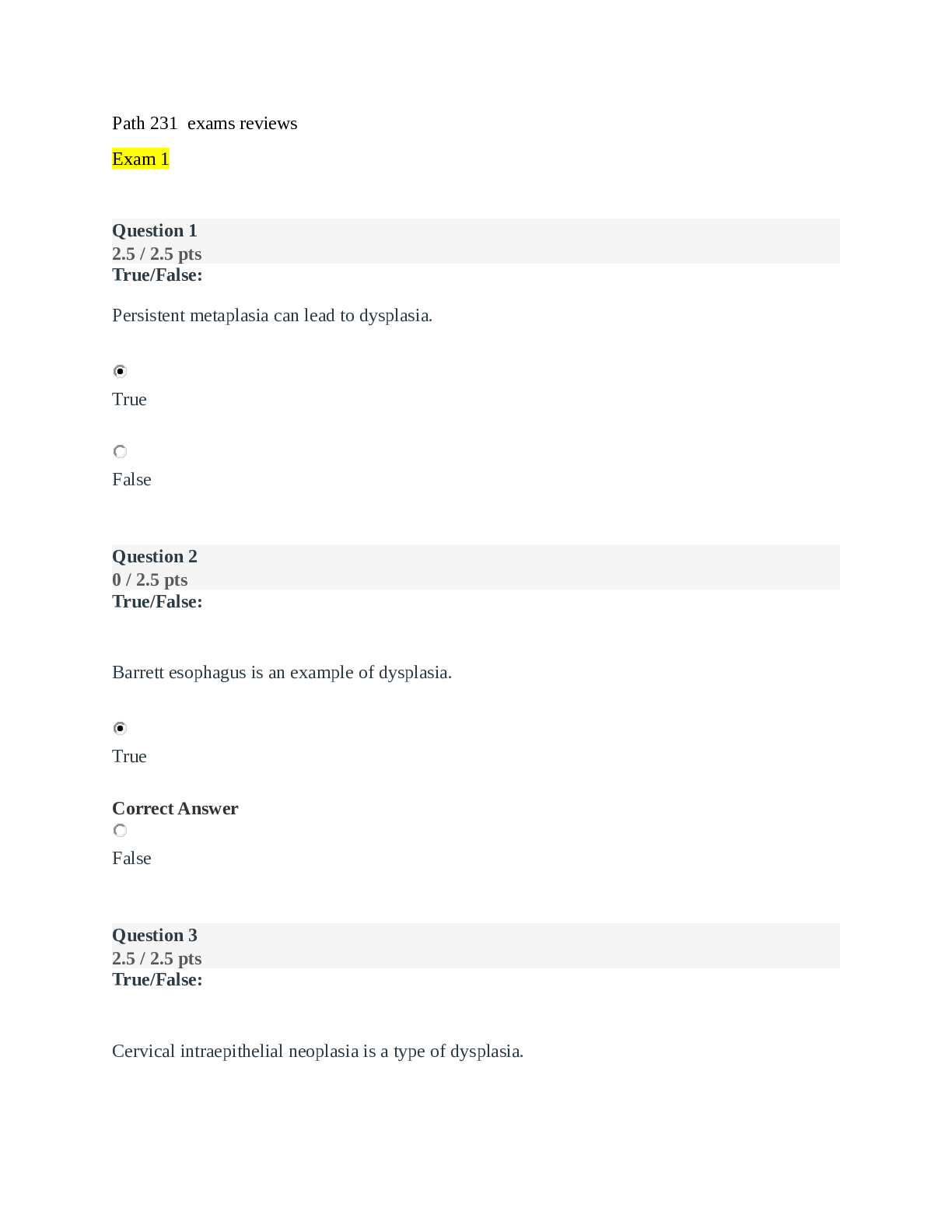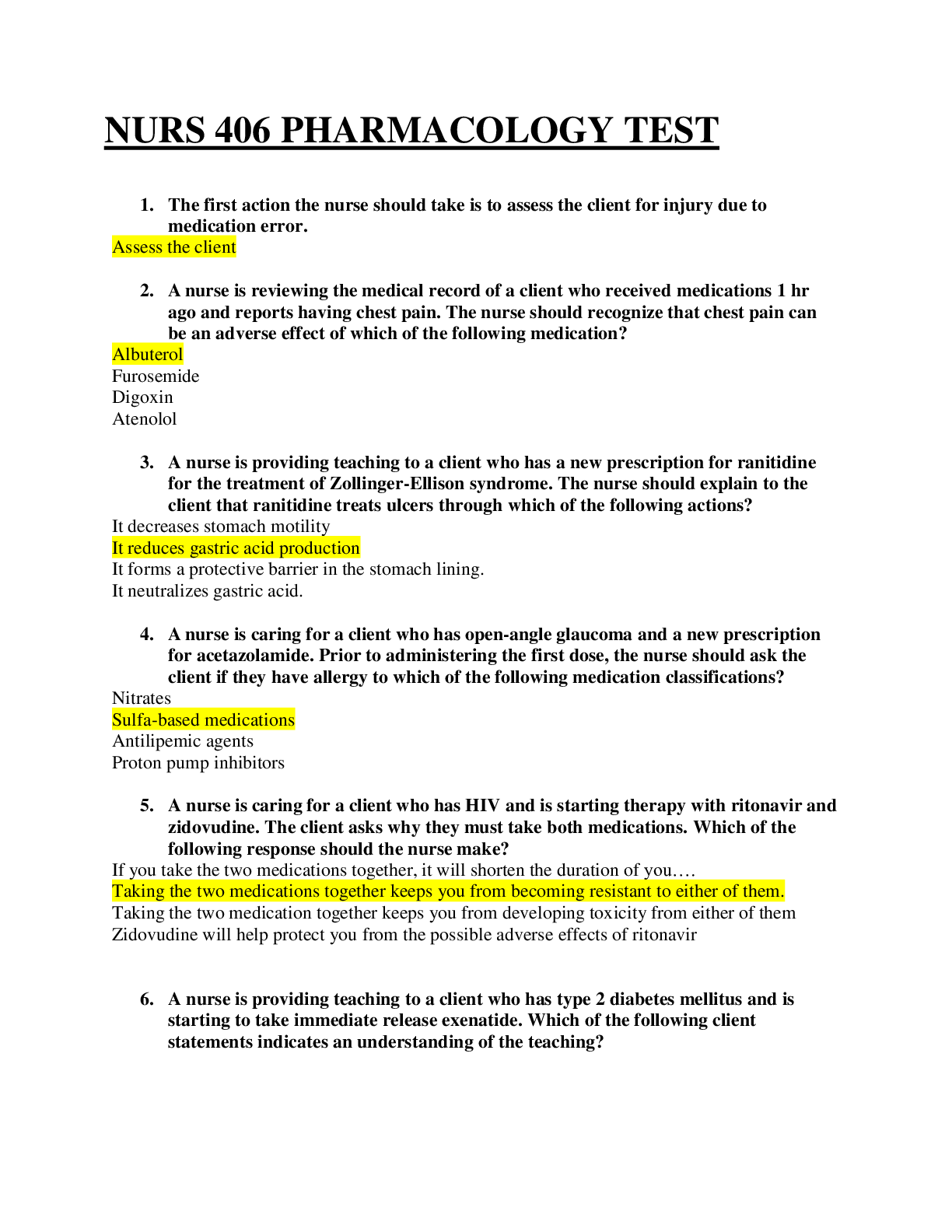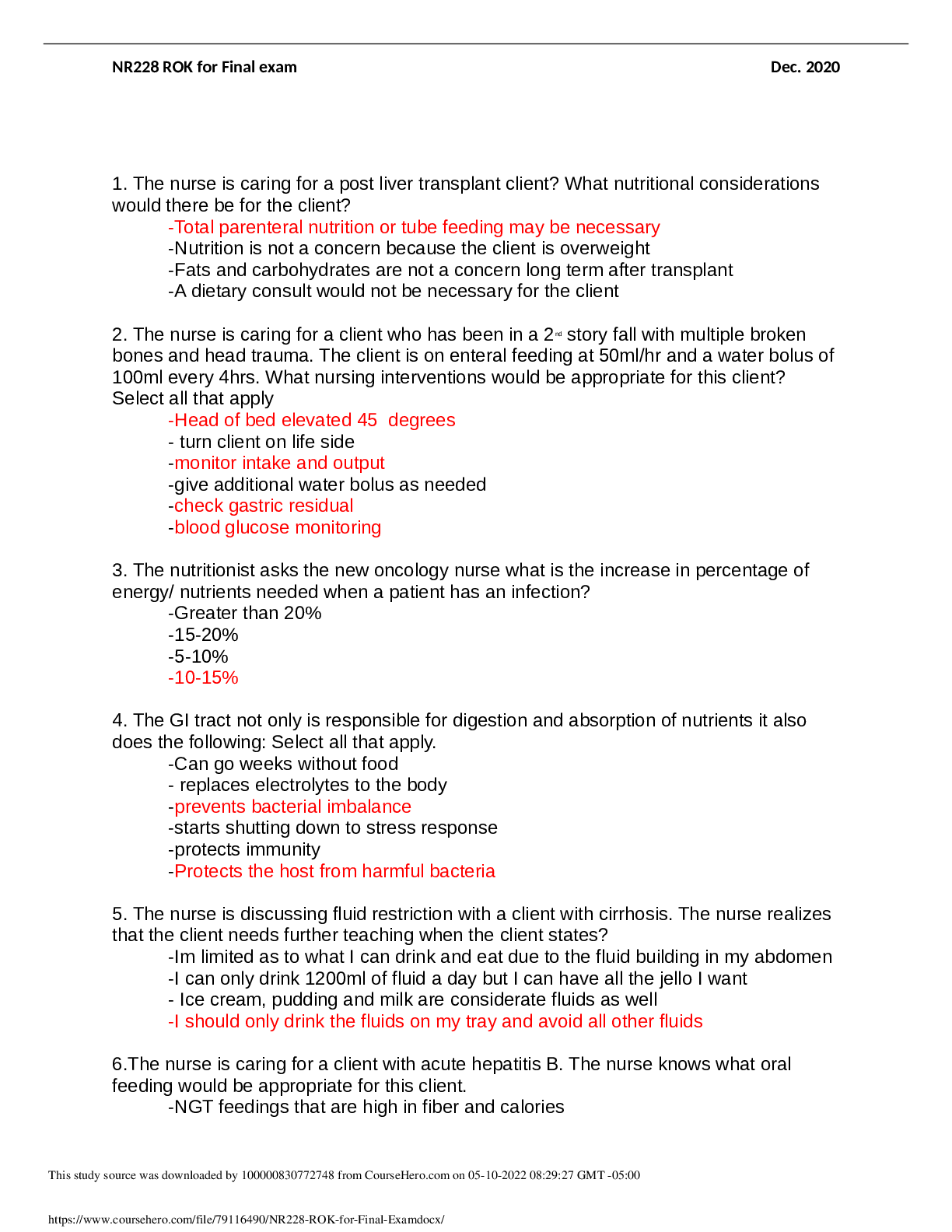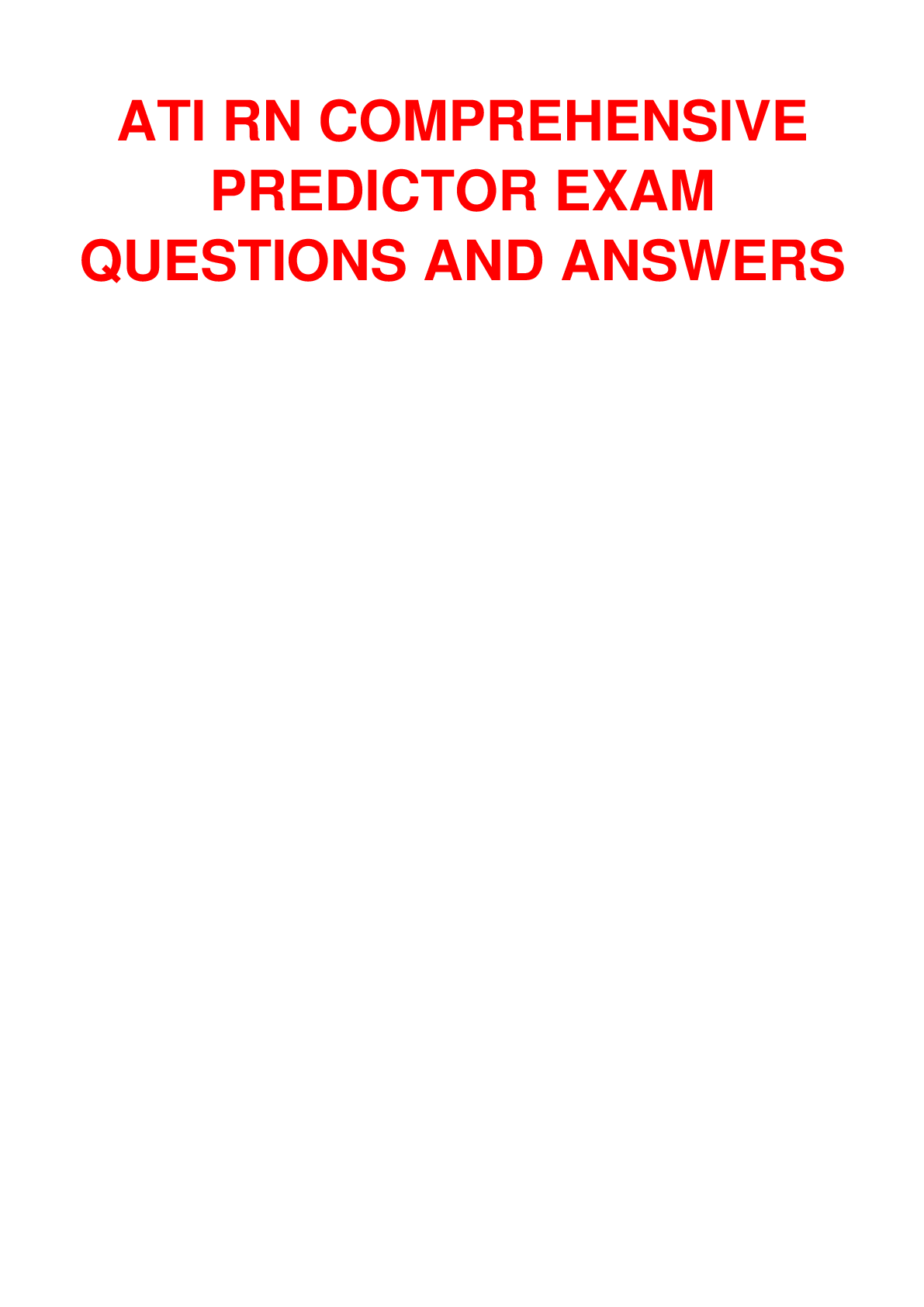Health Care > EXAM > Kaplan: Maternity A, B, C Exam Questions and Answers (All)
Kaplan: Maternity A, B, C Exam Questions and Answers
Document Content and Description Below
A client comes to the prenatal clinic for her first visit. The nursing history reveals that the client's last menstrual period was five months ago, and the client is sure she is pregnant because she h... as been feeling the baby move. Which of the following responses by the nurse is best? 1. "Since you have felt the fetal movement, I am sure that you are pregnant." 2. "Lie down so that I can listen for fetal heart tones with the Doppler." 3. "We'll collect a urine specimen for testing to confirm that you are pregnant." 4. "Have you noticed feeling more fatigued lately?" - ANSWER 2. "Lie down so that I can listen for fetal heart tones with the Doppler." Listening for fetal heart tones, seeing fetus on u/s, palpating fetal movement are all posivitive signs of preg. Not 1 bc fetal movement reported by pt. is a presumptive sign of preg. Not 3: urine test could be conducted as early as first day of a missed period, serum blood lvls may also be drawn, but ascultation of fetal heart tones= least invasive method. Not 4: Fatigue is a presumptive sign The nurse admits a patient to the postpartum unit two hours after a vaginal delivery. Three hours after admission the nurse ambulates the patient to the bathroom, and the patient states there is a sudden gush of bleeding from her vagina. The nurse understands that the increase in amount of bleeding is due to which of the following? 1. The lochia pooled in the patient's vagina when she was lying in bed 2. The patient has a tear in her cervix that needs to be repaired. 3. The patient's fundus is relaxed and requires massaging. 4. The patient's bladder is distended because she needs to void - ANSWER 1. The lochia pooled in the patient's vagina when she was lying in bed The flow of lochia increases during ambulation due to pooling in the vagina while pt is lying or sitting. Lochia flow can also increase during breastfeeding. Lochia contains blood, mucus, and uterine tissue and typically continues for 4-6 wks after delivery Not 2 bc cervical tear would result in excessive bright red bleeding Not 3 bc relaxed fundus can cause bleeding, but bleeding would continue to occur, not just when the client stands or ambulates Not 4 bc a distended bladder causes the fundus to rise above the umbilicus and does not cause a gush of fluid to occur. The nurse in the prenatal clinic assesses a client at 31 weeks gestation. The client's BP is 150/96, edema of the face and hands is noted, 3+ protein in the urine, and serum albumin level is 3 gm/dL. Which of the following instructions by the nurse is MOST important? 1. The client should decrease caloric intake 2. The client should eliminate all salt from her diet 3. The client should ensure adequate protein 4. The client should increase her intake of iron - ANSWER 3. The client should ensure adequate protein pt. has preE and should be placed on bedrest, lying on left side, and be instructed to maintain adequate intake of fluids and proteins. Proteins restore osmotic pressure Not 1: client should not diet, should maintain adequate intake of foods and fluids Not 2: salt restriction is not required bc preg women w/ hypertension typically have lower plasma volume. Edema is due to a decreased colloidal osmotic pressure from protein loss, not excess sodium in diet. IF pt has chronic HTN controlled by low-salt diet prior to preg. then decrease in salt would be recommended. Not 4: Altering iron in diet does not affect preE A 25 y/o primigravida diagnosed with type 1 diabetes mellitus reviews insulin regimen with the nurse. The nurse reinforces the importance of regular prenatal care and explains changes in insulin requirements will include which of the following? 1. insulin requirements will increase during pregnancy and decrease after delivery 2. insulin requirements will decrease during pregnancy and increase after delivery 3. insulin requirements will increase during pregnancy and remain increased after delivery. 4. insulin requirements decrease during pregnancy and remain decreased after delivery. - ANSWER 1. insulin requirements will increase during pregnancy and decrease after delivery Due to hormonal interferences in glucose metabolism, insulin requirements increase during preg. The need for more insulin is caused by hormones the placenta makes to help the baby grow. These hormones block the action of the mother's insulin. Immediately after delivery, the insulin requirements usually decrease abruptly. Pre-preg sensitivity to insulin will be regained and requirements will decrease A woman is in active labor when her membranes rupture. She expresses a concern to the nurse she is afraid of having a 'dry labor'. Which of the following responses by the nurse is MOST appropriate? 1. Amniotic fluid does not function as lubrication for the labor process 2. The sac actually impedes the progress of labor and if it had not ruptured, the doctor would have to do it artificially. 3. Labor is only slightly more difficult with early rupture of the amniotic sac. 4. Now that there is limited amniotic fluid, you may have to have a cesarean section. - ANSWER 1. Amniotic fluid does not function as lubrication for the labor process AF helps maintain temp, provides oral fluid, and cushion for fetus. It does not provide lubraication for birth. Secretions from Bartholin glands at the entrance of vagina help keep vagina lubricated. Not 2: AROM may agument labor, however answer 1 better addresses concern Not 3: ROM has no bearing on the difficulty of labor Not 4: amt of AF is not indicative of a c/s or vaginal birth. The nurse cares for a patient in labor. The patient suddenly shouts, "I have to push! I have to push!" The nurse determines that the patient is 8 cm dilated. Which of the following actions should the nurse take first? 1. instruct the patient to take a deep breath and bear down 2. apply pressure to the patient's fundus 3. coach the patient in relaxation techniques 4. encourage the patient to pant with pursed lips - ANSWER 4. encourage the patient to pant with pursed lips Encourage pant to prevent pushing. Instruct pt to avoid holding breathe by breathing in and out constantly or by raising chin and blowing pr panting Not 1: client is not completely dilated and should not push until 10 cm dilated. Not 3: It is more important to reestablish breathing to prevent pushing for the pt w/ strong urge to push The nurse provides education on increasing dietary iron to a client diagnosed with anemia. The nurse recommends the client to eat which food? (Select all that apply.) 1. Chicken liver 2. Pork chop 3. Hamburger 4. Bananas 5. Spinach 6. Tofu - ANSWER Chicken, spinach, tofu Chicken liver: liver is an excellent source of iron. Other concentrated sources include cooked artichoke and some fortified cereals Spinach: green leafy veggies and legumes are good sources of iron Tofu: good source, esp. for pt who don't eat meat Pork is not a concentrated source, but pork liver is. Hamburger is not a concentrated source. Beef does not contain as much iron as pork or chicken liver. Red meat in the form of steak contains more iron per serving than a hamburger. Organ meats are an excellent source of iron The nurse prepares the client for a total abdominal hysterectomy with bilateral salpingo-oophorectomy due to uterine cancer. The nurse observes that the client is talking continuously and has difficulty maintain eye contact. Which response by the nurse is BEST? 1. What are your concerns about the surgery? 2. Why isn't your husband here with you 3. Are you afraid that you are going to die? 4. You seem to be coping with the surgery very well 5. Are you scared that you will be in a lot of pain after surgery? 6. You have nothing to be worried about. Your surgeon is very good. - ANSWER 1. What are your concerns about the surgery? pt's behavior indicates anxiety The health care provider orders a colposcopy for the client. The nurse explains to the client that which is the purpose of this procedure? 1. Magnify the tissue for examination 2. Directly examine ovaries, fallopian tubes, uterus, and small intestine 3. View structures in the pelvis cavity 4. Visualize the bladder - ANSWER 1. Magnify the tissue for examination colposcopy examines the vagina and cervix using colpscope. This test identifies precancerous lesions of the cervix by magnifying tissue for examination. Tell pt bleeding may occur after procedure. Tampons can be used after, but should report heavy bleeding Colposcopy is preformed by laprascopy and preformed under gen. anesthesia Not 3: culdoscopy examines pelvic cavity. After procedure, postion pt. on abdomen w/ pillow underneat to expel air that entered abdominal cavity. Not 4: =cystoscopy, bladder A woman complains to the nurse that during the client's menstrual period she gains weight and gets muscle cramps. The nurse should suggest which of the following measure to alleviate the client's symptoms? 1. Take OTC analgesics, restrict caffeine, exercise moderately 2. Avoid analgesics and exercise 3. Restrict fluid intake, exercise moderately, increase caffeine intake. 4. Restrict sodium intake, restrict exercise, use sedatives - ANSWER 1. Take OTC analgesics, restrict caffeine, exercise moderately Use of mild analgesics, such as OTC NSAIDs, restriction of caffeine, and moderate excerise have all been shown to be effective in relief of weight gain, irritability, and muscle cramps. Not 4: decreasing sodium will decrease fluid retention, but exercise and NSAIDs are recommended to relieve symptoms A client is in labor. The nurse cares for the patient and observes the fetal monitor. The fetus is displaying category 3 FHR patterns. What should the nurse do first? 1. Call the PCP right away 2. Time the contractions from the beginning of one UC to the beginning of the next UC 3. Have the client roll onto the right side and take deep breaths 4. When the fetus' HR is baseline, stimulate the fetus to check for HR acceleration. - ANSWER 4. When the fetus' HR is baseline, stimulate the fetus to check for HR acceleration. Fetal stimulation is performed to elicit an acceleration 15x15 and/or FHR variability. It also provides additional info about fetal status when category 3 patterns are observed. Two methods: scalp stimulation and vibroacoustic, can be performed w/ or w/o ROM. Should be performed only when FHR is at baseline Not 1: bc should further assess the pt and fetus before calling Not 3: If fetus is sustaining late decels, the appropriate action is to roll pt onto left side and apply oxygen. When placing on LEFT side, it decreases pressure on the vena cava, which increases oxygenation to the fetus. The nurse cares for the client immediately after a normal vaginal delivery. Which action should the nurse take FIRST? 1. Observe the lochial flow 2. Palpate the fundus 3. Obtain a warming blanket 4. Obtain vital signs. - ANSWER 1. Observe the lochial flow Observing lochial flow= checking for hemorrhage. Not 2: assessing for firm fundus is important, but it is more important to observe for hemorrhage. If there is heavy bleeding, massaging the fundus would be appropriate Not 4: Vitals checked Q 15 mins during 1st hr delivery. The nurse notes that a 2 day old infant shows a tendency to bleed. The nurse understands this is MOST likely caused by which of the following? 1. Hemophilia 2. Absence of intestinal bacteria needed for the production of Vitamin K 3. Immature liver that is unable to synthesize clotting factors 4. Excessive breakdown of RBC's coupled with a delayed production of new ones. - ANSWER 2. Absence of intestinal bacteria needed for the production of Vitamin K At birth, infants have small amounts of vitamin K bc only small amts are passed through the placenta. Newborns don't produce Vitamin K until the 8th day, but can not produce suffcient amts until begin taking solid foods at 4-6 months. Vitamin K is administered to infants at birth Not 1: Hemophila is a hereditary blood diseases that causes prolonged coagulation time. Bleeding tendencies in newborn are due to inabilty to produce vitamin K. Not 3: Immature hepatic function causes neonate to be unable to deal w/ bilirubin production due to breakdown of RBCs after birth, which can lead to jaundice, not bleeding Not 4: Delayed production of RBC causes anemia, but does not increase bleeding in newborn. Newborns do no start producing new RBCs until about 1 month. = mild anemia (physiological or normal anemia). Once baby starts making new RBCs, RBC count will gradually go back to normal The nurse observes four newborns. Which of the following characteristics, if noted by the nurse, are MOST common in a preterm infant? 1. Red, wrinkled skin, lanugo, and hypotonic muscles 2. Vernix caseosa, silky hair, and faical edema 3. Absent nose bridge, depressed fontanels, and absent lanugo 4. Mottled skin, meconium stools, and hypertonic muscles - ANSWER 1. Red, wrinkled skin, lanugo, and hypotonic muscles Not 2: these describe a full term baby Vernix= white, cheesy substance that covers skin. Not 3: Depressed fontanels indicate fluid volume deficit. A low or absent nasal bridge may indicate genetic disorder. Neither of these characteristics are of a pretern infant. Not 4: Mottled skins= symptom of cold stress. Meconium stool is normal. Hypertonia is not seen with preterm infants. The nurse instructs a patient who recently had a modified radical mastectomy. The nurse states that it is important that the patient exercise her arm postoperatively to 1. increase muscle strength and diameter 2. maintain body balance 3. limit full range of motion 4. prevent lymphedema - ANSWER 4. Prevent lymphedema Pt should perform exercise and elevate extremity on affected side to prevent lymphema. Doing so helps flush back lymph fluid into circulation. Not 1: primary purpose of exercising affected arm is to prevent lymphedema= pooling of lymph circulation in the involved arm after removal of lymph glands. Not 3: Pt. should be encouraged to perform full range of motion, not limit. Early use of the affected arm will prevent atrophy and contractures and will enhance fluid return. The nurse instructs the woman about how to prevent conception using the basal body temp method. The nurse explains that during ovulation, the woman's basal body temp will change in which direction? 1. lowers significantly 2. rises significantly 3. is unchanged 4. rises slightly - ANSWER Rises slightly Just before ovulation, BBT drops by about 1F, At time of ovulation, BBT increases about 1-2F To assess an apical pulse on a 8lb, 4oz newborn infant, the nurse should take which of the following actions? 1. Place the diaphragm of the stethoscope between the nipple line and the sternal notch 2. Place the diaphragm of the stethoscope between the second and third intercostal spaces, the midaxillary line 3. Place the bell of the stethoscope between the fourth and fifth intercostal spaces, midclavicular line 4. Place the bell of the stethoscope between the second and third intercostal spaces, the midsternal line. - ANSWER 3. Place the bell of the stethoscope between the fourth and fifth intercostal spaces, midclavicular line The correct location for assessment of apical pulse in infants is at the 4th intercostal space, left midclavicular line. S1, normal closing of the mitral and tricuspid valves, is best heard at this location. Not 4: This assess the pulmonary area, S2 The nurse prepares a client for an abdominal hysterectomy. The client asks why she has to have a Foley catheter. Which statement by the nurse is MOST appropriate? 1. This will help you since you will be temporarily incontinent 2. This will enable us to measure your output accurately 3. This will allow you to heal by keeping your bladder decompressed 4. This will allow your bladder to recover after the surgery. - ANSWER This will allow you to heal by keeping your bladder decompressed It is more important to decompress the bladder immediately after surgery The nurse provides care for a client after an abdominal hysterectomy. The client asks when the indwelling urinary catheter will be removed. Which statement by the nurse is most appropriate? 1. You will keep the catheter until you develop a temperature 2. You will have the catheter until discharge so that we can measure your output accurately 3. The catheter will be removed as soon as you are able to ambulate 4. The catheter will be removed when there is no further bleeding from the bladder - ANSWER 3. The catheter will be removed as soon as you are able to ambulate An indwelling urinary catheter does enable staff to measure output accurately, but it is more important to decompress the bladder immediately after surgery Not 4: bladder is not affected by the surgery. No blood is expected in urine following a hysterectomy The nurse monitors a client at 30 weeks gestation, and the client states that she has periodic heartburn. It is MOST important for the nurse to make which of the following recommendations? 1. Lie down after eating a meal 2. Eat frequent small meals 3. Take alka-seltzer as needed 4. Sip iced tap water 5. Drink milk - ANSWER 2. Eat frequent small meals Pt should avoid large meals and gas-producing, spicy, fatty, or fried foods to decrease symptoms of GERD. Not 1: should not lie down after eating. Increased progesterone produced during preg slows down GI tract motility and relaxes cardiac sphincter allowing reflux Not 3: best to avoid sodium bicarbonate, which may interfere w/ sodium balance and aspirin. Pt may take OTC aids such as Tums, Rolaids, or Maalox for GERD symptoms. Not 4 or 5: While milk can temporarily buffer stomach acid, when the fat from milk is digested, it increases the acid in the stomach. Therefore it is best not to drink milk when experiencing an exacerbation of GERD. The nurse instructs a client in the prenatal clinic about nutrition during pregnancy. The nurse determines teaching is successful if the client selects which of the following food from a menu? 1. two eggs and 8oz milk 2. 2oz steak and 10oz beer 3. lettuce and tomato salad and 12oz OJ 4. bag of chips and 16oz soda - ANSWER two eggs and 8oz milk The nurse should place the HIGHTEST priority on monitoring a woman after a cesarean section for which of the following? 1. infection and pain 2. hemorrhage and shock 3. hemorrhage and pain management 4. dehydration and infection - ANSWER 3. Hemorrhage and shock Highest priority of all options. Pt is ob and postoperative pt. Observe airway and incisional dressing for bleeding and amt of lochia. An infant is born by vaginal delivery. At birth, the infant is crying and respiration and pulse rate are good. One minute after birth, the baby is noted to have slightly cyanotic extremities. At five minutes after birth, the extremities are pink. The nurse should record the baby's one-minute and five-minute Apgar scores a which of the following? 1. 8 and 9 respectively 2. 8 and 10 respectively 3. 9 and 10 respectively 4. 9 and 7 respectively - ANSWER 9 and 10 respectively All areas of assement are at the highest level at one minute except for the baby's color. Baby is crying w/ normal muscle tone, and heart rate. At one minute, baby's extremities are cyanotic and at 5 mins the extremities are pink. The nurse cares for a woman in labor. Which method should the nurse use to measure the frequency of a uterine contraction? 1. timing the contractions from end of one contraction to the end of the next contraction. 2. Timing the contraction from beginning of one to end of same contraction 3. Timing the contraction from peak of one to the beginning of next 4. Timing the contraction from beginning of one to beginning of next - ANSWER Timing the contraction from beginning of one to beginning of next A nurse accidentally bumps into a newborn's bassinet. The newborn jumps and pulls the extremities into the trunk. The nurse identifies the newborn is demonstrating which of the following reflexes? 1. Tonic neck 2. Moro's 3. Babinski's 4. Rooting - ANSWER Moro's Not 1: tonic neck= fencing position. Infant lies on back w/ head turn to one side. The arm and leg on that side of body will be in extension while extremeites on the opposite side will be flexed. Reflex disappears at 3-4 months Not 3: Stroking sole of the front of heel upward across ball of foot will cause all toes to fan Not 4: Rooting= infant turns toward any object when the cheek of mouth is stroke on that side The nurse cares for a patient after a breast biopsy. After the procedure, it is MOST important for the nurse to take which of the following actions? 1. apply ice to the area 2. preposition the patient for comfort 3. carefully transport the specimen to the lab 4. observe for bleeding - ANSWER observe for bleeding [Show More]
Last updated: 1 year ago
Preview 1 out of 36 pages
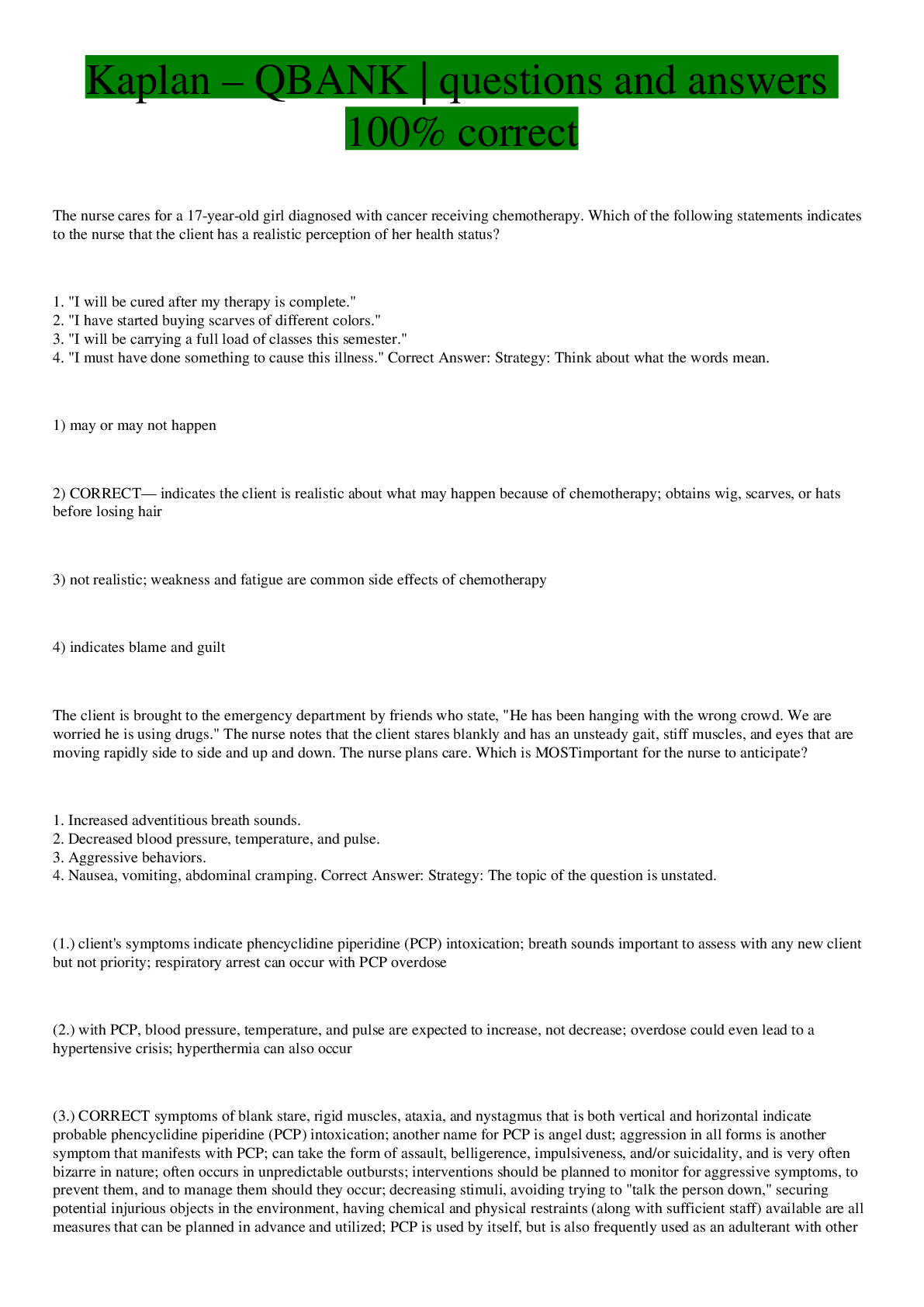
Reviews( 0 )
Document information
Connected school, study & course
About the document
Uploaded On
Aug 29, 2022
Number of pages
36
Written in
Additional information
This document has been written for:
Uploaded
Aug 29, 2022
Downloads
0
Views
32


